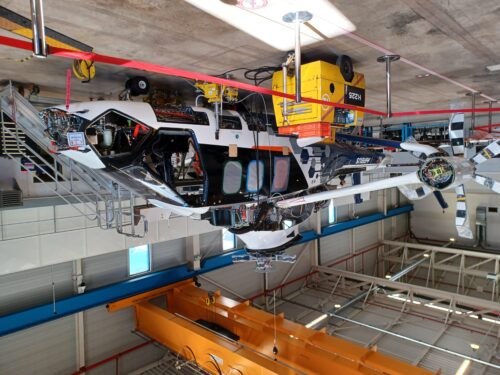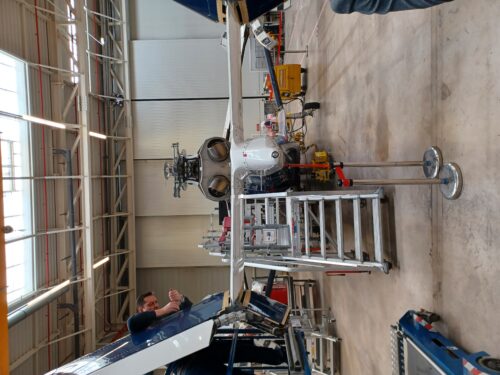
Airbus Helicopters Racer High-Speed Demonstrator in final preparation for its flight programme. Photo: RotorHub International
During a briefing at Airbus’s Marignane Headquarters on 13 February, Julien Guitton, Head of the Racer Programme, revealed the high-speed demonstrator is expected to be ready for its first flight by the end of March. The flight will mark the start of a 200-hour programme, which will be divided into two phases. The first will be dedicated to flight envelope expansion. With those capabilities confirmed, the next step will be to examine Racer applications in disciplines such as HEMS, SAR and Law Enforcement.
Where the X3 (or X cubed) borrowed much from the H155 and was unmistakably Dauphin-inspired, the Racer takes much from later conventional Airbus products and not only in terms of profile in major components. As Racer Chief Engineer Brice Makinadjian explained, that is no accident: “If you look at the upper deck, the engines, the gear box and rotor, they can all be directly transferred to conventional helicopters so you can imagine a time when an operator has a mixed fleet of both high-speed and conventional aircraft in operation.” Another example of this interoperability is the ease of conversion from conventional helicopters: “We found with the X3, and now putting pilots into the Racer simulator, that a 20-minute briefing is all that is needed, so that will be a cost saving for operators,” added Makinadjian.
While the Racer looks much like its conventional siblings and shares besides its upper deck fit out, the same Helionix avionics package, there has been a lot of thought about drag reduction. First, frontal drag has been shaved by going for a narrower fuselage cross-section. Second, a new main rotor fairing is expected to cut main rotor drag by 25%. Next, the adoption of a box wing biplane configuration brings several benefits by improving the efficiency of the main rotor in the low-speed and hover regime since the biplane allows the impedance of main rotor downwash to be significantly reduced, in the order of 1.5 to 2 times, while keeping the same wing loading in cruise flight. In addition, the move to the box wing allows the main

A look from astern, reveals the Racer’s asymmetric tailboom and box biplane wing configuration. Photo: RotorHub International
landing gear to be enclosed in the fuselage when retracted thus delivering further drag reduction. Furthermore, the box wing will induce a vortex turning counter to the lateral rotors which in turn will deliver ‘free thrust’ to the lateral rotors now in pusher configuration. This free thrust is expected to yield a 6-8% improvement in effectiveness.
Another design change from the X3 is the introduction of an asymmetric tailboom, which will generate anti-torque thrust from the main rotor downwash. According to wind tunnel data, this should lead to a 10% gain in efficiency. While many of the developments from the X3 are centred on reducing fuel burn through aerodynamic improvements, a 35 kt reduction in cruise speed optimises engine performance and makes innovations like the Safran Eco mode a possibility. In Eco mode, one engine will be shut down in cruise, with all thrust demands met using the remaining engine operating at around 90% power, which is expected to reduce fuel burn by 15%. There is no free ride in aviation, and in this case, the price is paid in the form of a reduction in cruise speed from 200 kts to 190. Noise emissions are also examined, with the ability to reduce the impact of blade/vortex interactions – the things that generate the distinctive whop-whop noise of a helicopter – by allowing blades to strike the vortex of the preceding blade out of its core, thus reducing noise output in noise sensitive phases of flight such as takeoff/initial climb or approach/landing. The lateral rotors, too, have been subjected to a noise treatment with tip speeds lowered from 255 metres per second to 190 m/s. Overall, Airbus said that while the Racer will be a bit slower than the X3, it will also be environmentally cleaner with a lower noise footprint and high commonality with its conventional helicopter products.





